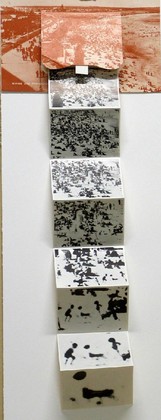AND NEW ESSAY SAYS FILM CAPTURES THE '60S

Okay, so I promised a couple of additional posts about Greetings for the weekend-- I guess for me, the weekend is still blobbed into this week. Anyway, two Sundays ago, MovieMan0283 posted a very nice essay about Greetings, which he said "presents us with a fully-formed vision, however different from the vision [Brian] De Palma later cultivated." MovieMan0283 feels that De Palma's early film was a different animal than the mumblecore stylings of the average independent film from young directors of recent years. And while De Palma would go on to make films that were more deliberately planned and shot, MovieMan0283 nevertheless sees that "there are signs that the filmmaker behind Scarface and Carrie is also the mind behind Greetings"...
For one thing, despite some intentionally sloppy stagings (De Palma sees Godard's jump cuts and raises him a jump cut in which the background and positions of the characters also changes) there's an obviously gifted eye behind the camera. One sequence is particularly striking: as the tired trio parade in Central Park, trying to keep one potential draftee awake so that he'll flunk his examination the next morning, one of the scruffy group breaks away to chat with a street personality, a photographer displaying his increasingly fuzzy blow-ups of a single photograph, interpreting their aesthetic while simultaneously acknowledging the debt to Antonioni's Blow-Up (a constant reference for De Palma here; particularly in relation to the examination of the Zapruder film). Meanwhile, as the zoom lens moves in closer and closer the two remaining buddies, punch-drunk from a night of staying awake, continue to cavort in the background, De Palma holding them in the increasingly tight shot as the heady dialogue continues in the foreground. Here and elsewhere, he's able to balance multiple elements for a dizzying kinesthetic effect.
ABOUT THAT PHOTOGRAPHER The artist in the scene mentioned above (and in the Greetings shot above) is Richard Hamilton, who is considered one of the fathers of the "pop art" movement (a movement that is satirized in Greetings when Robert De Niro's Jon labels his voyeuristic project "peep art"). At left is the piece Hamilton is showing to Gerrit Graham's Lloyd, titled "A Postal Card for Mother," in which a series of blow-ups of a beach scene are folded out accordion-like from the source photograph. The same year that Greetings was released, Hamilton designed the famous-iconic cover for the Beatles' "White Album," as well as the poster inserted inside the double-LP package, for which he asked for and was given hundreds of unpublished photos of the band to sort through.
The artist in the scene mentioned above (and in the Greetings shot above) is Richard Hamilton, who is considered one of the fathers of the "pop art" movement (a movement that is satirized in Greetings when Robert De Niro's Jon labels his voyeuristic project "peep art"). At left is the piece Hamilton is showing to Gerrit Graham's Lloyd, titled "A Postal Card for Mother," in which a series of blow-ups of a beach scene are folded out accordion-like from the source photograph. The same year that Greetings was released, Hamilton designed the famous-iconic cover for the Beatles' "White Album," as well as the poster inserted inside the double-LP package, for which he asked for and was given hundreds of unpublished photos of the band to sort through.
THE '60S IN A NUTSHELL
MovieMan0283 goes on to discuss how Greetings seems to capture a moment from the 1960s when "new" and "old" coexisted:
The 60s - and Greetings - are close enough to the 50s for some macho, un-PC social attitudes to remain (even as the movie's characters mock social conventions and Establishment politics). The film is so close to the clean-cut Camelot of '63 that the Kennedy references seem au courant, yet it is also close enough to the 70s to employ the stylistic range and adult content which that decade would make de rigeur. This, to me, captures the fascination of the 60s in a nutshell: not so much that the era represented the "new" as that it represented the crosshairs of "new" and "old" where World War II was something people in their thirties remembered while schoolchildren would grow up to found dot-com companies, where the traces of classical black-and-white cinema still lingered but the wide-ranging possibilities of the movies' future was just barely over the horizon. The changes happened so fast that for a brief moment, "new" and "old" co-existed - it was modern America's adolescence and Greetings captures that moment beautifully.
Updated: Thursday, April 2, 2009 11:29 PM CDT
Post Comment | View Comments (2) | Permalink | Share This Post



